China: As water demands grow sharply, supply is shrinking
Loading...
| Miyan County, China
A 15-foot band of eroded red clay that surrounds Miyun Reservoir, one of Beijing’s largest sources of fresh water, serves as a stark reminder of the region’s severe water shortage.
Built 100 miles northeast of the capital in the 1960s, the reservoir has operated at less than a third of its capacity for years. A massive project now under way to divert water to Beijing from southern China will help alleviate demand, but protecting the reservoir from pollution remains a separate challenge.
China has 20 percent of the world’s population but only 7 percent of its fresh water – and it is quickly running out of the vital fluid.
Efforts to boost supply have provided temporary relief for major cities, but the central government is scrambling to preserve what water is left. Expanded conservation work, higher water prices, and new industrial regulations are all on the table.
“The demand is growing but the supply is shrinking,” says Zhang Yan, program coordinator of the International Union for Conservation of Nature (IUCN), a global environmental organization in Beijing. “There is just less and less water.”
Environmentalists and local authorities have promoted forest restoration as a key tool for conserving water. Trees and shrubs now cover upward of 70 percent of the Miyun watershed, a dramatic uptick from a half century ago, when forests covered less than 10 percent of the region. The plants help stave off erosion and improve the reservoir’s water quality by filtering out pesticides, fertilizers, and other toxic chemicals.
No panacea
“So far we’ve been focusing on Beijing,” says Shen Qianqian, international program coordinator for the Beijing Forestry Society. “Now we want to upscale to other areas across China.”
With the hope of expanding their work, BFS and its partner organizations plan to launch a fund next month to raise money for similar projects at major watersheds near China’s largest cities. In addition to providing funding for forest restoration, the fund will also help pay for outreach programs to promote sustainable development.
Ms. Shen says the project is promising. But environmentalists warn that much more work is needed to ensure China’s water security. While forest restoration is far from a panacea for a problem so large, experts say it can help.
Beijing, which lies in China’s arid north, presents an especially difficult task. Rapid growth in and around the city has drained nearby rivers, reservoirs, and underground aquifers that took millenniums to fill. The water table underneath the capital has dropped about 1,000 feet since the 1970s. Nearby watersheds are quickly drying up.
Consequently, Beijing’s 22 million residents have to make do with an ever-shrinking water supply that’s estimated to meet the needs of only 12 million, according to the IUCN.
It’s the sort of projection of scarcity usually associated with countries on the Arabian Peninsula.
Water for a super city?
How shortages of water, among other issues, might fit with a government plan to make Beijing the center of a new super city of 130 million people, is unclear.
Beijing is also bidding to host the 2022 Winter Olympics. Water-intensive events such as skiing would require the production of artificial snow in the mountains northwest of Beijing. The region’s semi-arid climate leaves little chance of natural snow. Instead, the ski venues would need to tap local reservoirs.
The South-to-North Water Diversion Project is intended to help satisfy the north’s growing thirst by diverting water from southern rivers. Water from the $80.5 billion project started flowing to Beijing in December. But even if it reaches full capacity, the project is likely only to stabilize the situation.
“It will help Beijing buy some time,” says Ma Jun, director of the Institute of Public and Environmental Affairs and one of China's most prominent environmentalists. “But we should make better use of this time,” he adds, urging the government to shift its focus from increasing supply to promoting conservation.
With public discontent mounting, the central government has grown increasingly aware of the looming water crisis. In 2011, it set a red line on total water use at 670 billion cubic meters by 2020 and 700 billion cubic meters by 2030.
Staying below those lines will be no small task. China Water Risk, a Hong Kong-based advocacy group, says the country’s success will depend on reducing demand, increasing efficiency, and controlling pollution. Protecting existing water sources such as Miyun Reservoir are part of the plan.
Change is afoot. In April 2014, Premier Li Keqiang declared a “war on pollution” that has led to a crackdown on heavy polluters such petrochemical and metal smelting factories. The Ministry of Environmental Protection (MEP) hit 160 factories with $18 million in pollution-related daily fines during the first four months of this year, according to China Water Risk.
“We expect the crackdown on pollution to intensify,” China Water Risk said in a report published in July, noting that the MEP has set aside more than $450 million to tackle heavy metal pollution in 30 cities this year.
Meanwhile, the government plans to introduce tiered pricing for residential water users nationwide this year. Beijing introduced a similar plan in 2014 and now charges three different rates based on a household’s annual water consumption.
Still, many environmentalists say that China has a long way to go. Decades of industrial development have left nearly a third of the country’s major rivers and 62 percent of its groundwater contaminated. Forest restoration can help, but it’ll take years reverse the damage.
“At this moment we haven’t seen the turning point,” Mr. Ma says. “I think things will continue to get worse before they get better.”





